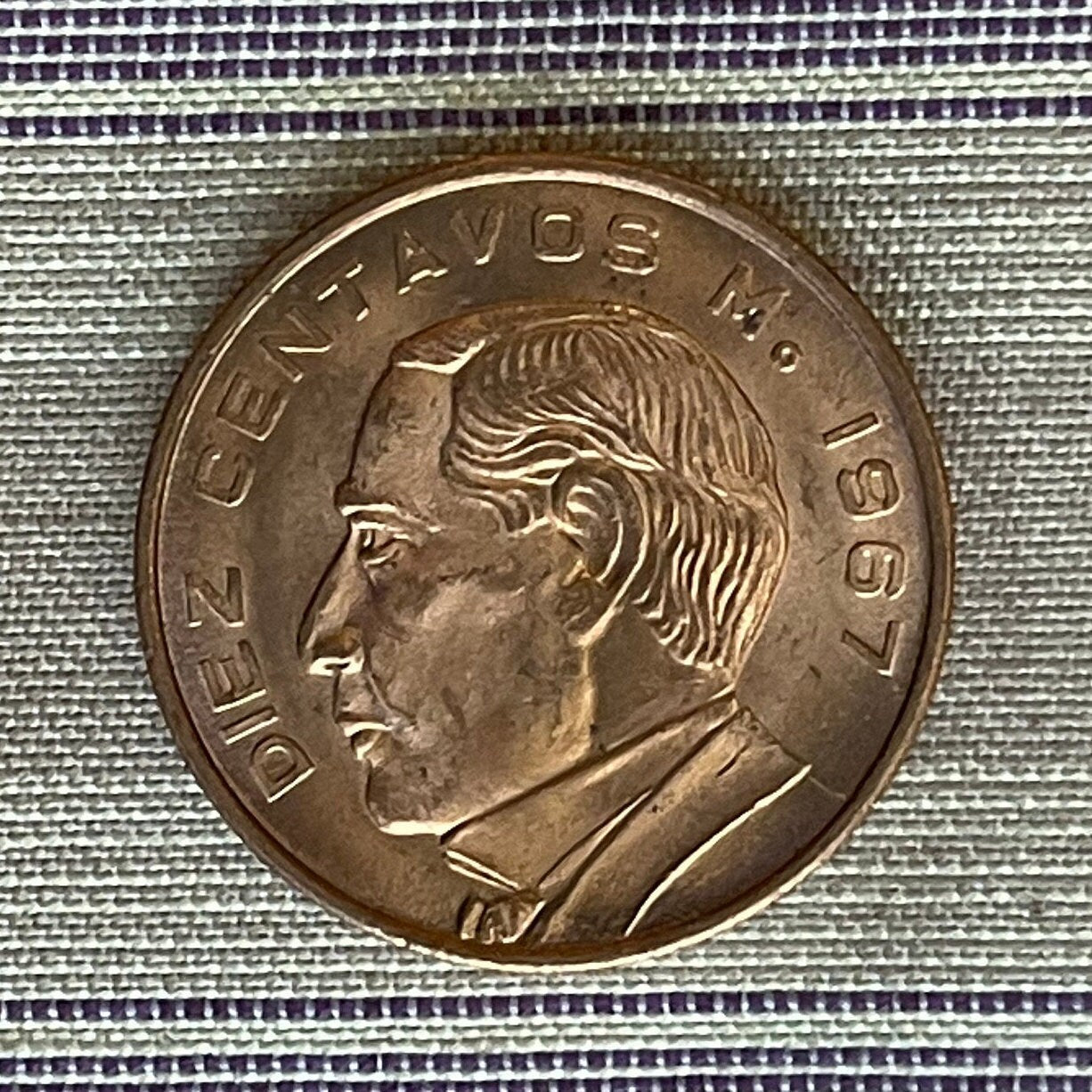elemintalshop
Benito Juárez & Eagle with Snake 10 Centavos Mexico Authentic Coin Money for Jewelry and Craft Making
Benito Juárez & Eagle with Snake 10 Centavos Mexico Authentic Coin Money for Jewelry and Craft Making
Couldn't load pickup availability
Benito Juárez & Eagle with Snake 10 Centavos Mexico Authentic Coin Money for Jewelry and Craft Making
Reverse: President Benito Juárez facing left, below denomination, mint mark, and date.
Lettering: DIEZ CENTAVOS
Translation: Ten Cents
Obverse: Mexican Eagle with Snake coat of arms under legend.
Lettering: ESTADOS UNIDOS MEXICANOS
Translation: United States of Mexico
Features
Issuer Mexico
Period United Mexican States (1905-date)
Type Standard circulation coin
Years 1955-1967
Value 10 Centavos (0.10 MXP)
Currency Estados Unidos - Peso (1905-1992)
Composition Bronze
Weight 5.5 g
Diameter 23.5 mm
Thickness 2 mm
Shape Round
Orientation Coin alignment ↑↓
Demonetized Yes
Number N# 2563
References KM# 433, Schön# 50
Wikipedia:
Benito Pablo Juárez García (Spanish: [beˈnito ˈpaβlo ˈxwaɾes gaɾˈsi.a]; 21 March 1806 – 18 July 1872) was a Mexican lawyer and politician, who served as the 26th president of Mexico from 1858 until his death in 1872. He was the first president of Mexico who was of indigenous origin. Born in Oaxaca to a poor Zapotec rural family and orphaned when he was young, he moved to Oaxaca City at the age of 12 to go to school. He was aided by a lay Franciscan, and enrolled in seminary, later studying law at the Institute of Sciences and Arts and becoming a lawyer. After being appointed as a judge, in his 30s he married Margarita Maza, a socially prominent woman of Oaxaca City. From his years in college, he was active in politics. Appointed as head justice of the nation's Supreme Court, Juárez identified primarily as a Liberal politician. In his life, he wrote briefly about his indigenous heritage.
When moderate liberal President Ignacio Comonfort was forced to resign by the Conservatives in 1858, Juárez, as head of the Supreme Court, assumed the presidency and the two governments competed. His succession was codified in the Constitution of 1857 but he survived in internal exile for a period during which he signed the McLane-Ocampo Treaty in 1859. He weathered the War of the Reform (1858–1860), a civil war between the Liberals and the Conservatives, and the French invasion (1861–1867), which was supported by Conservative monarchists. Never relinquishing office, although forced into exile to areas of Mexico not controlled by the French, Juárez tied Liberalism to Mexican nationalism. He asserted his leadership as the legitimate head of the Mexican state, rather than Emperor Maximilian, whom the French had installed.
When the French-backed Second Mexican Empire fell in 1867, the Mexican Republic with Juárez as president regained full power. For his success in ousting the European incursion, Latin Americans considered Juárez's tenure as a time of a "second struggle for independence, a second defeat for the European powers, and a second reversal of the Conquest."
Juárez is revered in Mexico as "a preeminent symbol of Mexican nationalism and resistance to foreign intervention." He understood the importance of a working relationship with the United States, and secured its recognition for his government during the War of the Reform. He held fast to particular principles, including the supremacy of civil power over the Catholic Church and part of the military; respect for law; and the depersonalization of political life. Juárez sought to strengthen the national government, asserting its central power over the states, a position that both radical and provincial liberals opposed.
After his death, the city and state of Oaxaca added "de Juarez" to their formal names in his honor, and numerous other places and institutions were named for him. His birthday (21 March) is celebrated as a national public and patriotic holiday in Mexico. He is the only individual Mexican to be so honored.
********
Wikipedia:
The coat of arms of Mexico (Spanish: Escudo Nacional de México, literally "national shield of Mexico") depicts a Mexican (golden) eagle perched on a prickly pear cactus devouring a rattlesnake. The design is rooted in the legend that the Aztec people would know where to build their city once they saw an eagle eating a snake on top of a lake. The image has been an important symbol of Mexican politics and culture for centuries. To the people of Tenochtitlan, this symbol had strong religious connotations, and to the Europeans, it came to symbolize the triumph of good over evil (with the snake sometimes representative of the serpent in the Garden of Eden).
The Law on the National Arms, Flag, and Anthem regulates the design and use of the arms. They feature in the centre of the flag of Mexico, are engraved on the obverse of Mexican peso coins, and are the basis of the Seal of the United Mexican States, the seal used on any official documents issued by the federal, state or municipal governmental authorities. The seal differs from the arms by the addition of the words Estados Unidos Mexicanos ("United Mexican States", the full official name of the country) in a semicircle around the upper half.
Share










5 stars review from Zilpa









